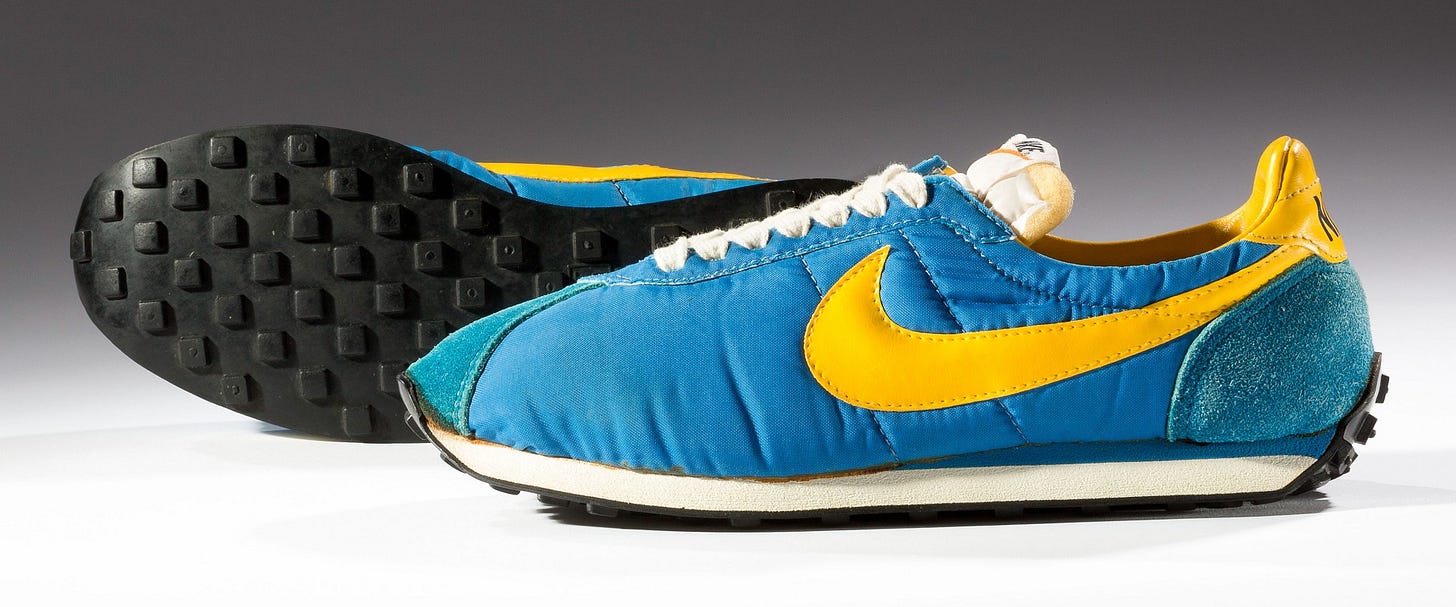Nike's Waffle Sole Shoe
A Serendipity Story
Serendipity Stories bring the practice of serendipity to life in real-world examples.
In 1971, Bill Bowerman was a co-founder of Nike (then called Blue Ribbon Sports) and a track coach at the University of Oregon. His obsession with improving his runners’ performance went far beyond normal coaching—he would examine his athletes’ shoe soles after every practice, studying how different surfaces wore down the rubber and analyzing grip patterns on tracks, grass, and pavement. Discontent with existing shoe technology, he spent countless hours pondering how to create lighter, more effective running shoes.
One morning during his regular breakfast routine, Bowerman sat at the kitchen table as his wife prepared waffles. The familiar sound of the waffle iron caught his attention, and as he watched the grid pattern close onto the batter, he had a lightning-bolt moment. He saw how those squares and grooves could translate into a revolutionary sole: lighter than average, but with superior grip. In that instant, his mind built a bridge between this breakfast equipment and the engineering problem that had consumed him for months.
Many people might have thought “well, that’s interesting” and returned to their coffee, but Bowerman had conviction in his new connection. He commandeered his wife’s waffle iron and began experimenting. The early attempts were disasters—rubber stuck and burned, creating unusable prototypes that filled the kitchen with acrid smoke and ruined multiple appliances. Yet through these chaotic, failed experiments, he persisted with unwavering determination to transform his idea into reality.
After finally creating workable prototypes, Bowerman tested them with his University of Oregon runners, refined the design through countless iterations, and eventually launched the Waffle Trainer in 1974.
The Waffle Trainer was an immediate hit. Runners all over the country, and eventually the world, wanted this new shoe, and Nike began its meteoric rise to fame. Since then, the shoes have changed, but the company’s reputation as an innovative, groundbreaking athletic-shoe provider has not.
Bowerman’s serendipitous breakfast marked the beginning of what would become Nike’s long-term success, demonstrating how breakthrough discoveries often lie in plain sight, available only to those who are open to potential solutions, remain alert to unexpected encounters, make bold new connections, and take action to turn their insights into reality.
The Practice Starts Now
Bill Bowerman's breakfast breakthrough wasn't luck—it was the result of a cultivated skill you can develop too. Right now, your next breakthrough might be hiding in the most ordinary moment of your day.
Serendipity isn't about waiting for lightning to strike; it's about training yourself to recognize when it does. Every challenge you face has its own "waffle iron moments" waiting to be discovered.
Three Ways to Begin:
Change your observation habit: Spend 5 minutes daily studying one ordinary object with fresh eyes. What patterns do you see? What problems does it solve?
Practice cross-pollination: When facing any challenge, deliberately look for solutions in completely unrelated fields. Stuck on a business problem? Study how nature solves similar challenges.
Cultivate relaxed attention: Notice when your mind is most receptive to new connections. Many insights happen during transitions—while walking, showering, or in quiet moments between focused tasks.
This Week's Challenge: Identify one persistent problem in your life. Spend 30 minutes in a completely different environment with that problem quietly in mind. Don't force connections. Just observe with curious attention.
References
Cyca, M. (2025, May 27). Nike receives patent for waffle-soled trainers—invented in a waffle iron. History. https://www.history.com/this-day-in-history/February-26/nike-patent-waffle-sole-trainers-invented-in-waffle-iron
Nike. (n.d.). The history of the Nike Moon Shoe. https://about.nike.com/en/magazine/nike-moon-shoe-waffle-iron-true-history

